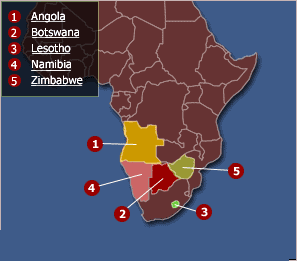 Research for this piece was conducted during the summer of 2003.
Research for this piece was conducted during the summer of 2003.
In Africa, the AIDS pandemic continues to infect millions. Meanwhile, famine, drought, and — in particular — nearly ubiquitous warfare have increased the disease’s ability to spread. At the end of 2000, over 3 million people had been displaced across the continent as war refugees. And in most African countries, expensive AIDS medication and treatment are simply not affordable or accessible to most people. The following AIDS facts help give an accurate picture:
- Out of 42 million living with AIDS worldwide at the end of 2002, 29.5 million were from Sub-Saharan Africa.
- Of the 5 million people newly infected with HIV in 2002, 3.5 million were from Sub-Saharan Africa.
- In 2002, 2.4 million people died of HIV/AIDS in Sub-Saharan Africa. The total number of HIV/AIDS-related deaths in the world that year was 3.1 million.
- 10 million people aged 15-24 are presently living with HIV in Africa.
- In four southern African countries, HIV prevalence rose to over 30 percent at the end of 2001: Botswana, 38.8 percent; Lesotho, 31 percent; Swaziland, 33.4 percent; Zimbabwe, 33.7 percent.
Source: UNAIDS
ANGOLA

Angola, emerging from a 27-year civil war, faces a crisis in which refugees who fled from the hostilities are now returning home with what could be a death sentence: HIV/AIDS. This situation is largely attributable to the fact that the countries bordering Angola — where many sought refuge during wartime — have been ravaged by AIDS. At the end of 2001, each carried a high percentage of AIDS per population: Zambia, 21.5 percent; Namibia, 22.5 percent; Botswana, 38.8 percent, and South Africa, 20.1 percent. So far, it is impossible to assess how many people in 2003 are living in Angola with AIDS, as refuges are still streaming into the country. A February UNAIDS article, however, quotes Angola’s health minister, who suggests that HIV has infected at least 1 million people there.
Thanks to its diamond-rich soils, Botswana has one of the strongest economies in Africa. That wealth, however, has not been a factor in curbing the country’s 38.8 percent HIV infection rate. In 2000, Botswana’s president attested that at least half of those who die natural deaths in the country die of AIDS-related ailments.
 BOTSWANA
BOTSWANA
Last year, Botswana declared a “war” on AIDS, financially supported by Bill Gates and the pharmaceutical giant Merck. Despite this major development, AIDS cases continue to steadily increase while projections suggest the life expectancy of the average person in the year 2010 will decrease to 29 years, according to the US Census bureau (this life expectancy figure would be 73.2 years without the influence of HIV/AIDS).
LESOTHO
Lesotho presently has a land degradation, agricultural, and food insecurity dilemma that has intensified and become harder to control with the emergence of AIDS, which has struck about a third of the country’s population.

Lesotho has the fourth largest AIDS population in the world. When a UN envoy visited Queen Elizabeth Hospital in Maseru, he found that 80 percent of its patients were HIV positive — a statistic belying the impact of the virus on the country’s health sector. Indeed, the insurgence of HIV/AIDS has paralyzed Lesotho’s workforce — which is rapidly decreasing, affecting all areas of the economy, especially agriculture and health
NAMIBIA
In 1998, AIDS was the leading cause of death in Namibia. According to UNAIDS, nearly 20% of the nation’s population was infected with the disease as of 1999. Namibia is the driest country in sub-Saharan Africa, which places tremendous importance on livestock as a source of agricultural income.

The loss of labor due to AIDS-related deaths and the increased costs of health care and funeral expenses, grave problems on their own right, debilitate the agricultural workers’ ability to manage livestock. Diseases go untreated, and animals are lost or slaughtered in the process of sale and inheritance that follow the death of an AIDS victim. Meanwhile, nearly a third of the country’s 15,000-member National Defense Force is infected with HIV/AIDS.
HIV-related diseases kill about 2,500 Zimbabweans every week, according to UN officials. Like many southern African countries, Zimbabwe has been struck by a serious famine and the AIDS pandemic has worsened the situation by depleting the human resources needed to farm and produce agriculture.

ZIMBABWE
A third of the country’s 11.6 million people suffer from HIV/AIDS. According to the Zimbabwe government, 70 percent of patients in hospitals are seeking HIV-related health care. Of the 2.2 million people with HIV, over 300,000 have full-blown AIDS.
